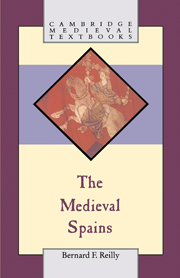Book contents
- Frontmatter
- Contents
- Maps
- 1 At the edge of empire
- 2 The Germanic kingdom in Iberia, 569–711
- 3 Iberia and the dār-al-Islam, 711–1009
- 4 Christian reconquista and African Empire, 1009–1157
- 5 The definition of Iberian autonomy: 1157–1295
- 6 The evolution of the medieval order in Iberia
- 7 The passing of medieval Iberia, 1248–1474
- An introductory bibliography
- Index
- Cambridge Medieval Textbooks
4 - Christian reconquista and African Empire, 1009–1157
Published online by Cambridge University Press: 05 June 2012
- Frontmatter
- Contents
- Maps
- 1 At the edge of empire
- 2 The Germanic kingdom in Iberia, 569–711
- 3 Iberia and the dār-al-Islam, 711–1009
- 4 Christian reconquista and African Empire, 1009–1157
- 5 The definition of Iberian autonomy: 1157–1295
- 6 The evolution of the medieval order in Iberia
- 7 The passing of medieval Iberia, 1248–1474
- An introductory bibliography
- Index
- Cambridge Medieval Textbooks
Summary
The century and a half which followed the collapse of the caliphate of Cordova was to see a fundamental reorganization of peninsular society. The respective positions of Christianity and Islam would achieve something like an equilibrium. After 711, all of the peninsula and its great river valleys were held by the Muslim and only the mountain country of Asturias was left to the Christian. By 1157, the latter had repossessed the basins of the Ebro, the Duero, and the Tajo as well as the Galician and north Portuguese coast. To al-Andalus was left the basins of the Guadiana and the Guadalquivir, the Levantine coast south of Tortosa and the Portuguese coast south of the Tajo. During the same period, however, Christian Iberia had gradually forged ever closer commercial, religious and cultural ties with western Europe while retaining a vigorous and autonomous political development of its own. Spanish Islam, on the other hand, after suffering political fragmentation was incorporated progressively into one or the other of the rising northern kingdoms or into that Moroccan Berber empire of the Murābit, which latter's culture was but a pale reflection of its own.
This massive reorientation of human society in the peninsula has many causes but one of the basic of them was demography. At some point in the tenth century the population of the northern, mountainous rim of Iberia began to expand sufficiently to enable it to flow southward and, with the aid of the Mozarab current of emigrés flowing northward from al-Andalus, to maintain itself in those new climes.
- Type
- Chapter
- Information
- The Medieval Spains , pp. 90 - 128Publisher: Cambridge University PressPrint publication year: 1993



